HYDE161
Go Kart Champion
Disclaimer: I am only providing my feedback to help people decide if they feel they would benefit from what I have installed and tested in my own car.
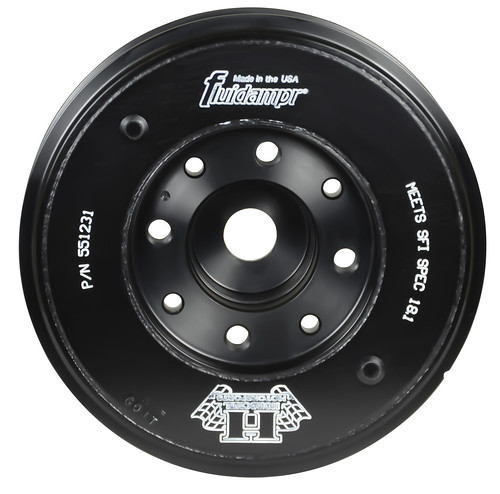

A Little Background on Harmonic Balancers aka Crank Pulleys:
A harmonic balancer reduces destructive crankshaft torsional vibration, which is the end-to-end twisting/rebound motion naturally generated during each power stroke. A harmonic balancer contributes to greater valve train and timing efficiency, plus reduces wear of critical engine components such as main bearings, oil pump and the crankshaft itself. A harmonic balancer often incorporates the main drive pulley and by appearance is often overlooked as having no essential function to the life of the engine. If the drive pulley is incorporated with the harmonic balancer, removing or changing it to a lightweight design, or using a low quality product may be the single biggest costly mistake.
The majority of passenger car and light trucks come equipped with an elastomer style harmonic balancer. These low-cost, rubber-based OEM harmonic balancers are tuned from the factory to protect only a narrow band of the worst harmonics and are intended for stock conditions. A stock elastomer damper is limited to function within the narrow predetermined frequency range under stock conditions and is typically only tuned for a 50hz peak variance. Move beyond its parameters and it may leave your critical engine components unprotected when torsional vibration is at its peak. If increased engine vibration is not compensated for, through using a performance damper such as a Fluidampr, it can lead to quicker destruction of main bearings, timing components, valve train components, belts and accessory pulleys, even catastrophic crankshaft failure.
Performance parts that increase torque, such as an air intake, exhaust, cams, ECU software upgrade, etc. may cause the damper to overwork itself and will increasingly accelerate elastomer harmonic balancer failure. Performance upgrades that change the composition of the rotating assembly such as, pistons, rods and flex plate/clutch or flywheel/torque converter will cause the OEM damper to be out-of-tune to provide optimum protection.
As the damper works harder, heat generated becomes trapped longer in the rubber. Since rubber is a poor dissipater of heat it will dry crack and/or heat bulge. As the rubber loses durometer and elasticity its ability to protect the engine diminishes with the real possibility of catastrophic failure. A common safety hazard found in street performance and racing occurs when the outer ring separating from the hub and launches inside the engine bay.
Fluidampr® Crank Pulley for Volkswagen TSI® Applications:
Unlike a stock elastomer harmonic balancer, Fluidampr performance dampers protect across a broad frequency range and can become more effective as magnitude increases throughout your RPM range. Each Fluidampr performance damper is designed for the engine application it is intended for. Fluidampr performance dampers consist of a free rotating inertia ring inside a laser sealed outer housing within tight tolerance of each other. Both the inertia ring and the outer housing are computer balanced to exceed OEM specifications during manufacturing. Between the two, an area referred to as the shear gap is pressure injected with viscous silicone. This specialized silicone maintains stability across an extreme temperature range and provides superior heat dissipation.
As soon as your engine fires torsional vibration is present. To damp its destructive effects, the outer housing turns at engine RPM, while the inner inertia ring immediately self-centers and is free to be ‘shocked’ by each torsional vibration event. As the inner inertia ring moves in-and-out of RPM with the outer housing, the shearing force through the silicone transforms the vibration to heat, which rapidly dissipates through the housing. Since the mass of the inertia ring is engulfed in a thin film of silicone and not directly connected to the crank, it can be calculated that only 2/3 of the total Fluidampr weight is rotating at RPM.
The Fluidampr design originated from top race engine builders requesting Vibratech TVD (formally Houdialle and parent company to Fluidampr) to bring its viscous damper technology engineered for long-life, high power diesel applications to professional motorsports in the early-1980s to replace failing elastomer designs. Viscous torsional dampers are used today as original equipment on select luxury sportscars, light-duty diesel trucks and even military spec engines. Meanwhile, nearly all high power engines that move our economy depend on a viscous damper for superior protection, performance and durability.
Fluidampr is a performance viscous damper. Viscous dampers remove vibration energy from the system by shearing a free rotating inertia ring back and forth through a highly viscous silicone fluid. This converts the vibration energy into heat, which is easily dissipated through the sealed inertia ring housing. A free rotating inertia ring adds an extra advantage of controlling torsional vibration across a broad frequency range and provides the necessary protection as engine modifications are made.
Previous to the Fluidampr® Crank Pulley for Volkswagen TSI® Applications, Fluidampr has successfully released 3 crank pulley options for the VR-6, 1.8T and 2.0 FSI/TFSI applications. Fluidampr is actively working with and currently used and offered by the following top VW/Audi engine builders/resellers:
USP Motorsports
INA Engineering
Integrated Engineering
034 Motorsports
Lightweight Crank Pulley Options:
Not one test has shown any improvement in torsional vibration control with a lightweight pulley. They are actually worse for an engine than an OEM rubber damper. Due to the fact they do nothing to control crankshaft twist, lightweight pulleys actually allow more vibrations back into internal engine components which may reduce the life of an engine. Fluidampr proved they put up the highest peak H.P. and torque numbers compared to lightweight crank pulley options, on only a 150hp opposed-four Subaru FA20 engine found in the Scion FR-S and Subaru BRZ (http://www.enginelabs.com/engine-te...idamprs-brian-lebarron-on-fr-sbrzwrx-dampers/) all due to the ability to reduce crankshaft twist which robs the engine of power.
Torsionals start at the engine and are transmitted all the way through. Every time the engine fires (every powerstroke of every cylinder) it twists the crankshaft ahead of its natural rotation and then the crank violently rebounds. This rebound is what creates torsional vibration (harmonics) and transmits them all the way back through the crankshaft and into the driveline, tranny, flex plates or flywheels, and any connecting components. The job of a damper is to absorb as much of this torsional vibration as possible without transmitting them back into the crank and so on. This is why lightweight pulleys are so dangerous to engines. They do nothing to absorb harmonics. You must have the proper amount of inertia mass to absorb the vibrations. This is why a Fluidampr is heavier than lightweight pulleys and most OEM rubber dampers and still creates more power while also reducing parasitic drag to accessories. So in short a Fluidampr does not make power, it frees up lost power.
Fluidampr® Performance Damper Product Description for the Volkswagen TSI Application:
Fluidampr® announces the release of a new performance crankshaft damper for Volkswagen TSI engines. The highly anticipated damper, part number 551231, fits the popular late model Volkswagen Golf GTI, Jetta, Passat and Audi A3. In addition the damper fits many more EA888.x engine designated models from Volkswagen and Audi.
Upgrading the stock elastomer style crank damper to a Fluidampr performance damper during the early stages of engine modifications improves long term optimum performance and durability by controlling crankshaft torsional vibration. Development testing at USP Motorsports on a Dynojet chassis dynamometer indicated nine peak horsepower and 16 peak ft-lbs torque gains over the stock crank damper when tested on a 2012 Jetta GLI equipped with a USP Downpipe, USP Stage 2 Intake, Spulen Throttle and Outlet Pipes, and APR Stage 2 tune on 93 octane.
The broad rpm range protection and smooth power delivery a Fluidampr performance damper provides allows for future engine upgrades, including common single disc clutch kits, without the need for a costly damper re-tune or replacement common with elastomer style harmonic dampers.
Benefits in Volkswagen TSI Applications:
-- Decreased engine vibration. No more flywheels, crank trigger wheels, or timing gears falling off of the crankshaft. This is unavoidable when revving past 8000rpm without an engine damper.
-- Decreased "Clutch/Gear Box Chatter" which is caused by lightweight single mass flywheels.
-- Reduction in rpm drops when shifting in a competitive environment.
-- Gains of 3-10whp and 5-13ft/lbs. torque depending on your current setup.
-- An overall more efficient and reliable engine.
The new Fluidampr performance damper for Volkswagen TSI applications is direct replacement and accepts the OEM crank damper removal tool. A four M8x1.25 pre-drilled bolt interface also accepts accessory drives, such as a dry sump system. Constructed from high tensile strength steel, components are precision CNC machined and high speed computer balanced during manufacturing. Finished in a corrosion resistant black zinc chromate finish and engraved timing mark. SFI 18.1 certified for professional motorsports. Made in USA.
Development testing in conjunction with INA Engineering showed a release of 5 peak horsepower over the OEM crank pulley on a stock Audi A3 Sedan. Further testing with USP Motorsports on a Dynojet chassis dynamometer indicated 9 peak horsepower and 16 peak ft-lbs torque gains over the stock crank pulley when tested on a 2012 Jetta GLI equipped with a USP Downpipe, USP Stage 2 Intake, Spulen Throttle and Outlet Pipes, and APR Stage 2 tune on 93 octane.
Why Does Fluidampr Use Silicone:
To learn more, I read the article Why Does Fluidampr Use Silicone? for a further explanation which I also posted below.
The engineers at Vibratech TVD, the parent company of Fluidampr and inventor of the viscous torsional vibration damper, have perfected the use of silicone for over 65 years. Without looking, some assume the fluid in a Fluidampr should be like motor oil or hydraulic shock fluid because that’s what is commonly used in other fluid dampening devices. This leads some to believe that our silicone turns to a gel over time after cutting a used one open. However, this is torsional vibration from internal combustion we’re dealing with. The silicone Fluidampr uses is 45,000 times more viscous than 30W motor oil!
Truth is, it’s a gel when we precisely fill the damper housing on the assembly line and it needs to be a gel to do its job. Fluidampr performance dampers and Vibratech TVD heavy duty dampers are rated to -40oF. They can be found protecting engines in the frigid cold of the Alaskan oil fields, to the non-stop abuse of heavy construction equipment, to the blistering heat of the race track. Viscous engine dampers are the preferred choice for premium engine builders and are stock equipment in supercars such as the Audi R8 and Lamborghini Gallardo.
Answer:
What a great question. One of the most common questions I hear, I am assuming this is due to competitors smear advertising and once it catches word of mouth it spreads. In short, NO! there is nothing you need to worry about in sub-zero degree temps.
We use a viscous silicone fluid that is often referred to as a gel because of its gel like properties and it is very sticky to the touch. On average the fluid is 45,000 times thicker than 30 weight motor oil. Unlike rubber which degrades rapidly under heat, viscous silicone is very thermally stable. At minimum it is good from -40°F - +300°F before it would even think of changing properties.
Viscous silicone technology has been used OEM on over 90% of heavy duty diesel engines since 1946 when our sister company Vibratech TVD invented the technology and is now found OEM in many high end flagship cars such as Ford GT 40, Audi R8, Lamborghini Gallardo, McLaren M838T, Ferrari California T, and even into the light duty diesel market with 6.7 Dodge Ram Cummins. OEM’s use cheap elastomeric dampers because they are adequate under stock operating conditions and a much cheaper than a viscous damper to manufacture. On these super cars cost is not as important as protecting a high performance engine. All I ever have to tell people is would these OEM’s both in heavy duty diesel ($500,000+ engines) and in high performance gas engines if there was a problem.[/I]
In addition to that misinformation I have heard or read from many others, as per Fluidampr, the silicone does not settle in the damper, it does not go bad over time, it does not freeze in the winter and it should not have any effect on the alternator as it is not an overdrive or underdrive pulley.
Fluidampr® Performance Damper (Fluidampr Part # 551231) Unboxing:
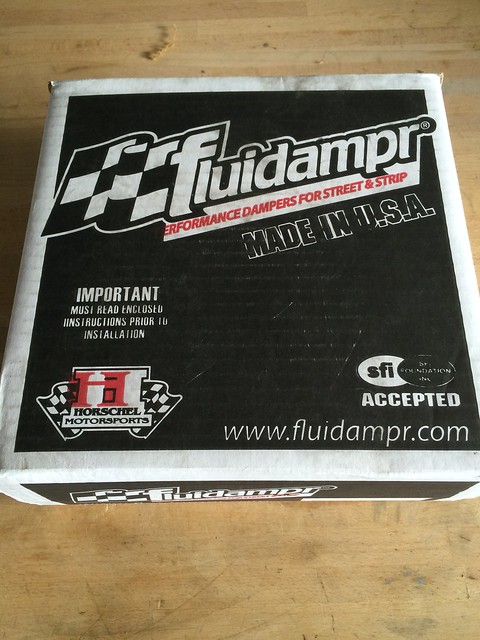
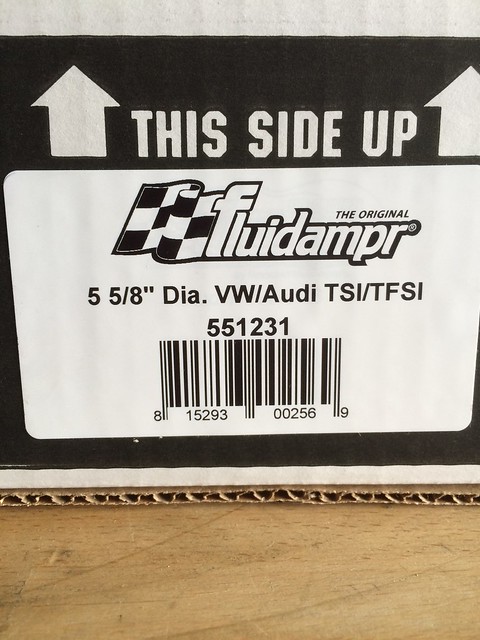
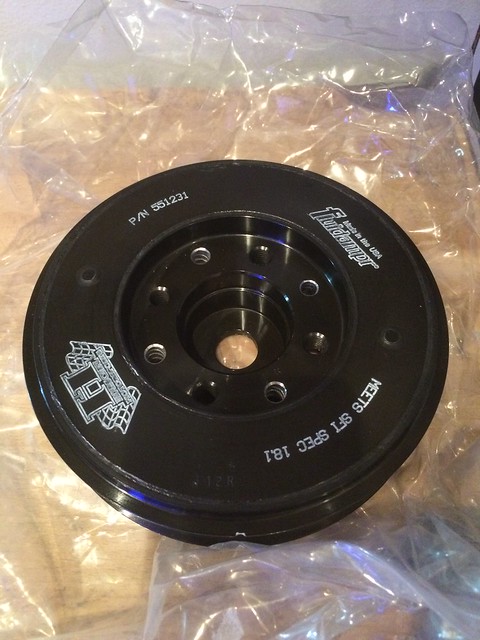
Fluidampr® Performance Damper Comparison:
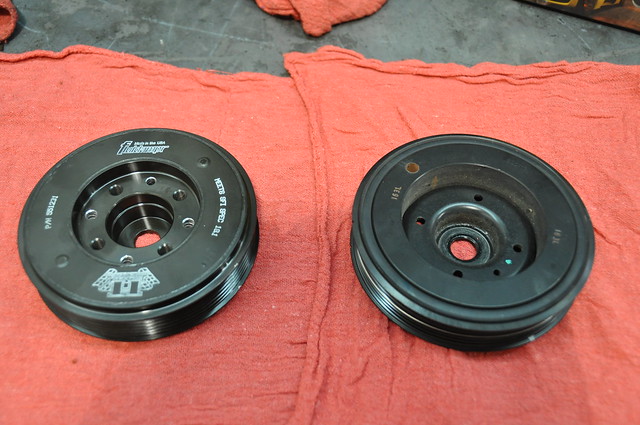
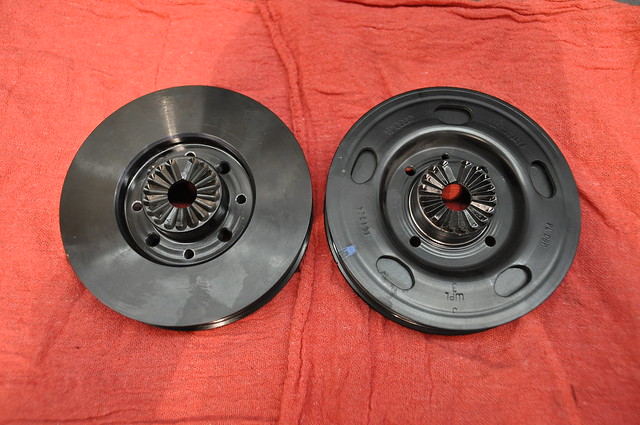
Fluidampr® Performance Damper Weight Difference:
After seeing the weight difference, I read the article Harmonic Balancer & Drive Pulley Weight Is A Good Thing for a further explanation which I also posted below.
The weight and density of the damper, even if it is just a crank pulley, is essential to the performance of protecting your engine against torsional vibration. The torsional vibration energy created with every power stroke of your engine is repeatedly ‘punching’ the crankshaft damper. When you hit a light weight punching bag it does not absorb much force. In fact it swings away and right back at you. Or in the instance of your crankshaft, sends the torsional vibration right back through the crankshaft to do damage. When you hit a heavy weight punching bag it absorbs a lot of energy and doesn’t budge. Inertia mass and stopping this destructive force is what a quality damper is designed to do. For any damper to effectively prevent damage to your engine, it must have some weight behind it. Just like a big heavy punching bag.
Our engineers design for superior torsional vibration control across the entire rpm range and optimal weight. In a Fluidampr the inertia ring mass is free floating within the housing. Once the crankshaft starts rotating centrifugal force and torsional vibration takes the weight of the internal inertia ring off the crankshaft. This does allow the engine to rev faster. You’ll notice two weights listed in our catalogs, overall weight and rotating weight. In engine building, rotating weight is the more important number to focus on.
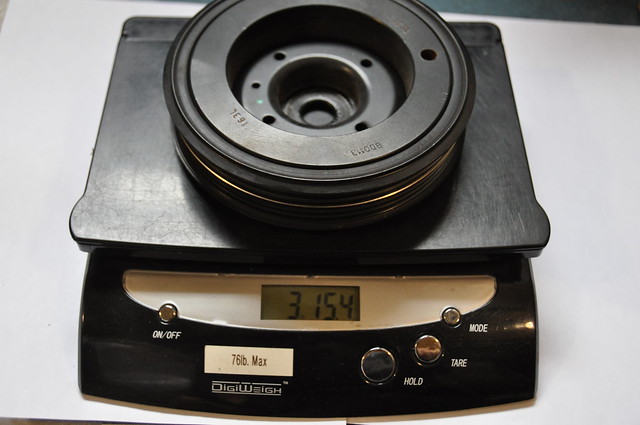
3lbs 15.4oz
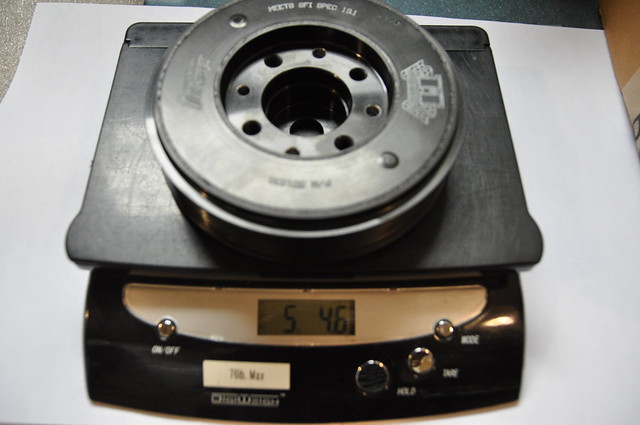
5lbs 4.6oz
Fluidampr® Performance Damper Installation:
Thanks to KMD Tuning in Saddle Brook, NJ, installation took 1 hour max. Since Fluidampr reverse engineered the fitment based on the OEM unit, it’s a pretty straightforward job; just remove the turbo outlet pipe, serpentine belt and then install the Fluidampr performance damper with the OEM crank pulley tool. I highly recommend sourcing a new crankshaft stretch bolt and installing at the 150Nm+90 torque rating.
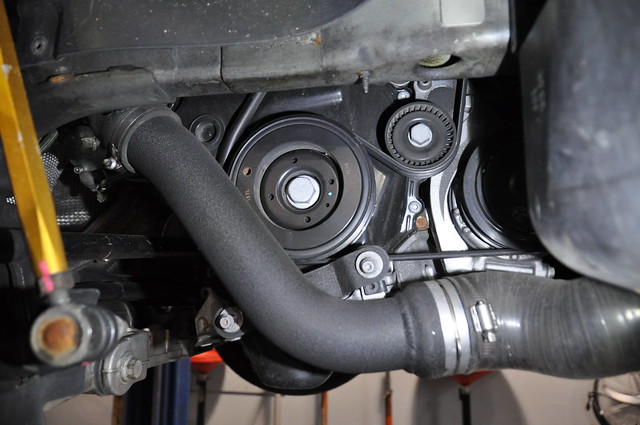
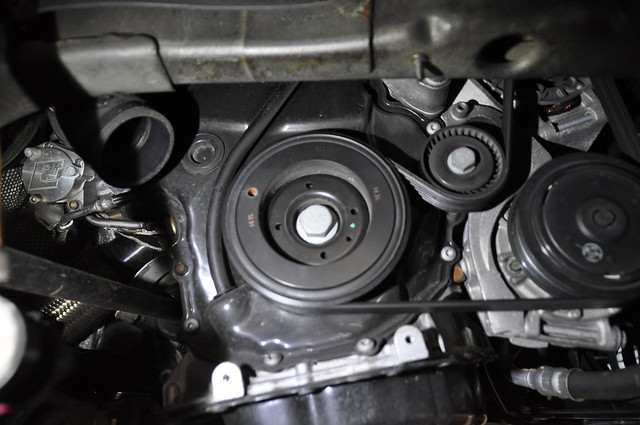
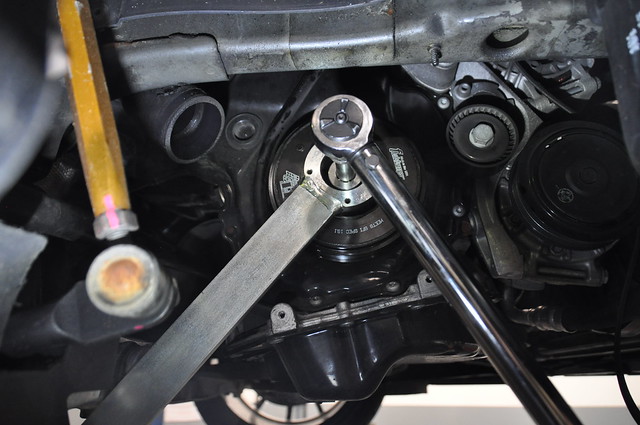
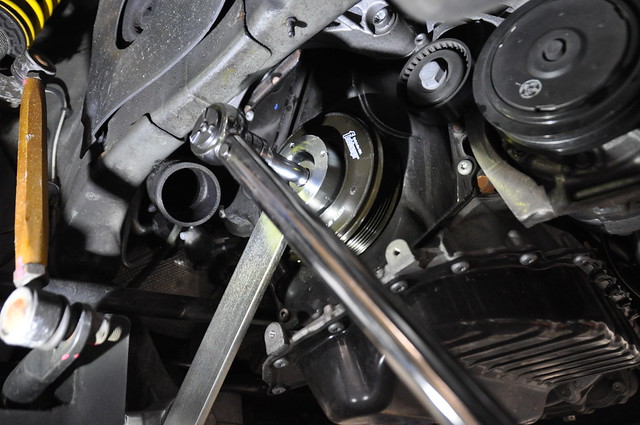
Fluidampr® Performance Damper Installed:
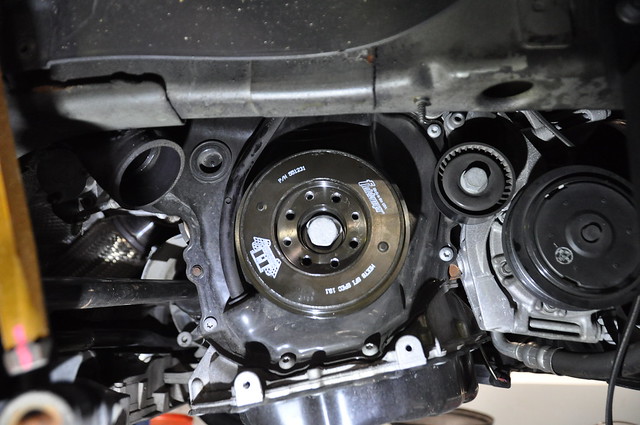
Fluidampr® Performance Damper Overall Results and Recommendations:
Fluidampr’s claim to fame, particularly with VW/Audi engines, is the ability of a viscous damper to control harmonics at all frequencies regardless of RPM while providing power gains. This is something we may not get with elastomeric (rubber) based dampers that are sensitive to frequencies beyond what it’s tuned for. With added aftermarket components and revving well past operating range, again, it may change where the harmonics occur and cause additional NVH that may not have been present before. Most often we see this when moving from an OEM dual mass flywheel to a single mass flywheel or when adding engine/trans/subframe mounts to a car. I can’t say that a Fluidampr performance damper will completely remove the typical single mass flywheel NVH (and it may), but it should certainly help reduce any vibrations caused by changing the rotational inertia of the engine.
Now, I am currently running an OEM dual mass flywheel so I can’t speak to the Fluidampr performance damper effect in this area but with fully up rated mounts, there was a very evident reduction in low end vibrations when driving around town. NVH is all subjective but without a doubt, the engine seemed much more settled and quieter when driving around town in the lower and mid RPM range. It’s something I can’t really explain but I really enjoyed this noticeable change after the first hour of driving after the Fluidampr performance damper was installed. For the daily driver the change is absolutely noticeable and may warrant more love in the love/hate relationship as we trade off comfort for performance. I also wanted to see if I could decrease rev hang or shorten rev up / rev drop. With the OEM dual mass flywheel It looks like an indiscernible impact on this area, nothing like moving to a single mass flywheel of course. I hope someone with a single mass flywheel can test this Fluidampr performance damper for NVH reduction and rev hang or shorter rev up / rev drop.
In terms of power, initially, Fluidampr could not speak to potential increase in HP and TQ numbers, but they told me realistic HP gains could be anywhere from 5-20 HP, keeping in mind that every application is different and complicated by the specific combination of hardware and software options on each car. After a few WOT runs on the highway, the car ripped up top. With the K04’s quick turbo spool up, acceleration was smooth and controlled. The butt dyno was definitely sweating for a moment or two.
Since the “butt dyno” doesn’t provide hard facts or results, more recently USP Motorsports provided their own DynoJet testing on a 2012 APR Stage 2 Jetta GLI. Keep in mind this is the OEM IHI turbo with full bolt-on hardware and APR Stage 2 software. I want to reiterate “OEM IHI turbo” again as the results are astonishing, and for K04 owners like myself, we may experience an even larger increase in HP and TQ numbers which I felt right after a few WOT runs on the highway.

From the recent USP Motorsports DynoJet testing, at 4,228 RPM there was a 20 HP gain and at peak HP through each run, there was a 9 HP gain and a 16 FT/LB TQ gain. Previous to 3,500 RPM, there was a slight decrease in HP and TQ compared to OEM but that was because the OEM is targeting a specific frequency based on the durometer of rubber used. The Fluidampr performance damper functions all the way through the power band but may be slightly inferior at the exact range the OEM damper targets. Basically, the OEM crank pulley may perform a little better in a short, specific range but the Fluidampr performance damper works all the way through the range and much better as RPM increases.
So to recap, the Fluidampr performance damper for the Volkswagen TSI application shows astonishing HP and TQ increases on the OEM IHI turbo with full bolt-on hardware and APR Stage 2 software, it soaks up engine harmonics outside of the OEM crank pulley’s effective range after tuning our cars, it provides a smoother around town driving experience, it may possible soak up NVH on single mass flywheel setups (still to be tested) and may protect my engine for extended mileage? Yea, I’m glad I went with this upgrade for various reasons as you can tell. Since many of us typically buy performance parts with top end/aggressive driving in mind, this Fluidampr performance damper will certainly give us what we are looking for.


A Little Background on Harmonic Balancers aka Crank Pulleys:
A harmonic balancer reduces destructive crankshaft torsional vibration, which is the end-to-end twisting/rebound motion naturally generated during each power stroke. A harmonic balancer contributes to greater valve train and timing efficiency, plus reduces wear of critical engine components such as main bearings, oil pump and the crankshaft itself. A harmonic balancer often incorporates the main drive pulley and by appearance is often overlooked as having no essential function to the life of the engine. If the drive pulley is incorporated with the harmonic balancer, removing or changing it to a lightweight design, or using a low quality product may be the single biggest costly mistake.
The majority of passenger car and light trucks come equipped with an elastomer style harmonic balancer. These low-cost, rubber-based OEM harmonic balancers are tuned from the factory to protect only a narrow band of the worst harmonics and are intended for stock conditions. A stock elastomer damper is limited to function within the narrow predetermined frequency range under stock conditions and is typically only tuned for a 50hz peak variance. Move beyond its parameters and it may leave your critical engine components unprotected when torsional vibration is at its peak. If increased engine vibration is not compensated for, through using a performance damper such as a Fluidampr, it can lead to quicker destruction of main bearings, timing components, valve train components, belts and accessory pulleys, even catastrophic crankshaft failure.
Performance parts that increase torque, such as an air intake, exhaust, cams, ECU software upgrade, etc. may cause the damper to overwork itself and will increasingly accelerate elastomer harmonic balancer failure. Performance upgrades that change the composition of the rotating assembly such as, pistons, rods and flex plate/clutch or flywheel/torque converter will cause the OEM damper to be out-of-tune to provide optimum protection.
As the damper works harder, heat generated becomes trapped longer in the rubber. Since rubber is a poor dissipater of heat it will dry crack and/or heat bulge. As the rubber loses durometer and elasticity its ability to protect the engine diminishes with the real possibility of catastrophic failure. A common safety hazard found in street performance and racing occurs when the outer ring separating from the hub and launches inside the engine bay.
Fluidampr® Crank Pulley for Volkswagen TSI® Applications:
Unlike a stock elastomer harmonic balancer, Fluidampr performance dampers protect across a broad frequency range and can become more effective as magnitude increases throughout your RPM range. Each Fluidampr performance damper is designed for the engine application it is intended for. Fluidampr performance dampers consist of a free rotating inertia ring inside a laser sealed outer housing within tight tolerance of each other. Both the inertia ring and the outer housing are computer balanced to exceed OEM specifications during manufacturing. Between the two, an area referred to as the shear gap is pressure injected with viscous silicone. This specialized silicone maintains stability across an extreme temperature range and provides superior heat dissipation.
As soon as your engine fires torsional vibration is present. To damp its destructive effects, the outer housing turns at engine RPM, while the inner inertia ring immediately self-centers and is free to be ‘shocked’ by each torsional vibration event. As the inner inertia ring moves in-and-out of RPM with the outer housing, the shearing force through the silicone transforms the vibration to heat, which rapidly dissipates through the housing. Since the mass of the inertia ring is engulfed in a thin film of silicone and not directly connected to the crank, it can be calculated that only 2/3 of the total Fluidampr weight is rotating at RPM.
The Fluidampr design originated from top race engine builders requesting Vibratech TVD (formally Houdialle and parent company to Fluidampr) to bring its viscous damper technology engineered for long-life, high power diesel applications to professional motorsports in the early-1980s to replace failing elastomer designs. Viscous torsional dampers are used today as original equipment on select luxury sportscars, light-duty diesel trucks and even military spec engines. Meanwhile, nearly all high power engines that move our economy depend on a viscous damper for superior protection, performance and durability.
Fluidampr is a performance viscous damper. Viscous dampers remove vibration energy from the system by shearing a free rotating inertia ring back and forth through a highly viscous silicone fluid. This converts the vibration energy into heat, which is easily dissipated through the sealed inertia ring housing. A free rotating inertia ring adds an extra advantage of controlling torsional vibration across a broad frequency range and provides the necessary protection as engine modifications are made.
Previous to the Fluidampr® Crank Pulley for Volkswagen TSI® Applications, Fluidampr has successfully released 3 crank pulley options for the VR-6, 1.8T and 2.0 FSI/TFSI applications. Fluidampr is actively working with and currently used and offered by the following top VW/Audi engine builders/resellers:
USP Motorsports
INA Engineering
Integrated Engineering
034 Motorsports
Lightweight Crank Pulley Options:
Not one test has shown any improvement in torsional vibration control with a lightweight pulley. They are actually worse for an engine than an OEM rubber damper. Due to the fact they do nothing to control crankshaft twist, lightweight pulleys actually allow more vibrations back into internal engine components which may reduce the life of an engine. Fluidampr proved they put up the highest peak H.P. and torque numbers compared to lightweight crank pulley options, on only a 150hp opposed-four Subaru FA20 engine found in the Scion FR-S and Subaru BRZ (http://www.enginelabs.com/engine-te...idamprs-brian-lebarron-on-fr-sbrzwrx-dampers/) all due to the ability to reduce crankshaft twist which robs the engine of power.
Torsionals start at the engine and are transmitted all the way through. Every time the engine fires (every powerstroke of every cylinder) it twists the crankshaft ahead of its natural rotation and then the crank violently rebounds. This rebound is what creates torsional vibration (harmonics) and transmits them all the way back through the crankshaft and into the driveline, tranny, flex plates or flywheels, and any connecting components. The job of a damper is to absorb as much of this torsional vibration as possible without transmitting them back into the crank and so on. This is why lightweight pulleys are so dangerous to engines. They do nothing to absorb harmonics. You must have the proper amount of inertia mass to absorb the vibrations. This is why a Fluidampr is heavier than lightweight pulleys and most OEM rubber dampers and still creates more power while also reducing parasitic drag to accessories. So in short a Fluidampr does not make power, it frees up lost power.
Fluidampr® Performance Damper Product Description for the Volkswagen TSI Application:
Fluidampr® announces the release of a new performance crankshaft damper for Volkswagen TSI engines. The highly anticipated damper, part number 551231, fits the popular late model Volkswagen Golf GTI, Jetta, Passat and Audi A3. In addition the damper fits many more EA888.x engine designated models from Volkswagen and Audi.
Upgrading the stock elastomer style crank damper to a Fluidampr performance damper during the early stages of engine modifications improves long term optimum performance and durability by controlling crankshaft torsional vibration. Development testing at USP Motorsports on a Dynojet chassis dynamometer indicated nine peak horsepower and 16 peak ft-lbs torque gains over the stock crank damper when tested on a 2012 Jetta GLI equipped with a USP Downpipe, USP Stage 2 Intake, Spulen Throttle and Outlet Pipes, and APR Stage 2 tune on 93 octane.
The broad rpm range protection and smooth power delivery a Fluidampr performance damper provides allows for future engine upgrades, including common single disc clutch kits, without the need for a costly damper re-tune or replacement common with elastomer style harmonic dampers.
Benefits in Volkswagen TSI Applications:
-- Decreased engine vibration. No more flywheels, crank trigger wheels, or timing gears falling off of the crankshaft. This is unavoidable when revving past 8000rpm without an engine damper.
-- Decreased "Clutch/Gear Box Chatter" which is caused by lightweight single mass flywheels.
-- Reduction in rpm drops when shifting in a competitive environment.
-- Gains of 3-10whp and 5-13ft/lbs. torque depending on your current setup.
-- An overall more efficient and reliable engine.
The new Fluidampr performance damper for Volkswagen TSI applications is direct replacement and accepts the OEM crank damper removal tool. A four M8x1.25 pre-drilled bolt interface also accepts accessory drives, such as a dry sump system. Constructed from high tensile strength steel, components are precision CNC machined and high speed computer balanced during manufacturing. Finished in a corrosion resistant black zinc chromate finish and engraved timing mark. SFI 18.1 certified for professional motorsports. Made in USA.
Development testing in conjunction with INA Engineering showed a release of 5 peak horsepower over the OEM crank pulley on a stock Audi A3 Sedan. Further testing with USP Motorsports on a Dynojet chassis dynamometer indicated 9 peak horsepower and 16 peak ft-lbs torque gains over the stock crank pulley when tested on a 2012 Jetta GLI equipped with a USP Downpipe, USP Stage 2 Intake, Spulen Throttle and Outlet Pipes, and APR Stage 2 tune on 93 octane.
Why Does Fluidampr Use Silicone:
To learn more, I read the article Why Does Fluidampr Use Silicone? for a further explanation which I also posted below.
The engineers at Vibratech TVD, the parent company of Fluidampr and inventor of the viscous torsional vibration damper, have perfected the use of silicone for over 65 years. Without looking, some assume the fluid in a Fluidampr should be like motor oil or hydraulic shock fluid because that’s what is commonly used in other fluid dampening devices. This leads some to believe that our silicone turns to a gel over time after cutting a used one open. However, this is torsional vibration from internal combustion we’re dealing with. The silicone Fluidampr uses is 45,000 times more viscous than 30W motor oil!
Truth is, it’s a gel when we precisely fill the damper housing on the assembly line and it needs to be a gel to do its job. Fluidampr performance dampers and Vibratech TVD heavy duty dampers are rated to -40oF. They can be found protecting engines in the frigid cold of the Alaskan oil fields, to the non-stop abuse of heavy construction equipment, to the blistering heat of the race track. Viscous engine dampers are the preferred choice for premium engine builders and are stock equipment in supercars such as the Audi R8 and Lamborghini Gallardo.
Answer:
What a great question. One of the most common questions I hear, I am assuming this is due to competitors smear advertising and once it catches word of mouth it spreads. In short, NO! there is nothing you need to worry about in sub-zero degree temps.
We use a viscous silicone fluid that is often referred to as a gel because of its gel like properties and it is very sticky to the touch. On average the fluid is 45,000 times thicker than 30 weight motor oil. Unlike rubber which degrades rapidly under heat, viscous silicone is very thermally stable. At minimum it is good from -40°F - +300°F before it would even think of changing properties.
Viscous silicone technology has been used OEM on over 90% of heavy duty diesel engines since 1946 when our sister company Vibratech TVD invented the technology and is now found OEM in many high end flagship cars such as Ford GT 40, Audi R8, Lamborghini Gallardo, McLaren M838T, Ferrari California T, and even into the light duty diesel market with 6.7 Dodge Ram Cummins. OEM’s use cheap elastomeric dampers because they are adequate under stock operating conditions and a much cheaper than a viscous damper to manufacture. On these super cars cost is not as important as protecting a high performance engine. All I ever have to tell people is would these OEM’s both in heavy duty diesel ($500,000+ engines) and in high performance gas engines if there was a problem.[/I]
In addition to that misinformation I have heard or read from many others, as per Fluidampr, the silicone does not settle in the damper, it does not go bad over time, it does not freeze in the winter and it should not have any effect on the alternator as it is not an overdrive or underdrive pulley.
Fluidampr® Performance Damper (Fluidampr Part # 551231) Unboxing:



Fluidampr® Performance Damper Comparison:


Fluidampr® Performance Damper Weight Difference:
After seeing the weight difference, I read the article Harmonic Balancer & Drive Pulley Weight Is A Good Thing for a further explanation which I also posted below.
The weight and density of the damper, even if it is just a crank pulley, is essential to the performance of protecting your engine against torsional vibration. The torsional vibration energy created with every power stroke of your engine is repeatedly ‘punching’ the crankshaft damper. When you hit a light weight punching bag it does not absorb much force. In fact it swings away and right back at you. Or in the instance of your crankshaft, sends the torsional vibration right back through the crankshaft to do damage. When you hit a heavy weight punching bag it absorbs a lot of energy and doesn’t budge. Inertia mass and stopping this destructive force is what a quality damper is designed to do. For any damper to effectively prevent damage to your engine, it must have some weight behind it. Just like a big heavy punching bag.
Our engineers design for superior torsional vibration control across the entire rpm range and optimal weight. In a Fluidampr the inertia ring mass is free floating within the housing. Once the crankshaft starts rotating centrifugal force and torsional vibration takes the weight of the internal inertia ring off the crankshaft. This does allow the engine to rev faster. You’ll notice two weights listed in our catalogs, overall weight and rotating weight. In engine building, rotating weight is the more important number to focus on.

3lbs 15.4oz

5lbs 4.6oz
Fluidampr® Performance Damper Installation:
Thanks to KMD Tuning in Saddle Brook, NJ, installation took 1 hour max. Since Fluidampr reverse engineered the fitment based on the OEM unit, it’s a pretty straightforward job; just remove the turbo outlet pipe, serpentine belt and then install the Fluidampr performance damper with the OEM crank pulley tool. I highly recommend sourcing a new crankshaft stretch bolt and installing at the 150Nm+90 torque rating.




Fluidampr® Performance Damper Installed:

Fluidampr® Performance Damper Overall Results and Recommendations:
Fluidampr’s claim to fame, particularly with VW/Audi engines, is the ability of a viscous damper to control harmonics at all frequencies regardless of RPM while providing power gains. This is something we may not get with elastomeric (rubber) based dampers that are sensitive to frequencies beyond what it’s tuned for. With added aftermarket components and revving well past operating range, again, it may change where the harmonics occur and cause additional NVH that may not have been present before. Most often we see this when moving from an OEM dual mass flywheel to a single mass flywheel or when adding engine/trans/subframe mounts to a car. I can’t say that a Fluidampr performance damper will completely remove the typical single mass flywheel NVH (and it may), but it should certainly help reduce any vibrations caused by changing the rotational inertia of the engine.
Now, I am currently running an OEM dual mass flywheel so I can’t speak to the Fluidampr performance damper effect in this area but with fully up rated mounts, there was a very evident reduction in low end vibrations when driving around town. NVH is all subjective but without a doubt, the engine seemed much more settled and quieter when driving around town in the lower and mid RPM range. It’s something I can’t really explain but I really enjoyed this noticeable change after the first hour of driving after the Fluidampr performance damper was installed. For the daily driver the change is absolutely noticeable and may warrant more love in the love/hate relationship as we trade off comfort for performance. I also wanted to see if I could decrease rev hang or shorten rev up / rev drop. With the OEM dual mass flywheel It looks like an indiscernible impact on this area, nothing like moving to a single mass flywheel of course. I hope someone with a single mass flywheel can test this Fluidampr performance damper for NVH reduction and rev hang or shorter rev up / rev drop.
In terms of power, initially, Fluidampr could not speak to potential increase in HP and TQ numbers, but they told me realistic HP gains could be anywhere from 5-20 HP, keeping in mind that every application is different and complicated by the specific combination of hardware and software options on each car. After a few WOT runs on the highway, the car ripped up top. With the K04’s quick turbo spool up, acceleration was smooth and controlled. The butt dyno was definitely sweating for a moment or two.
Since the “butt dyno” doesn’t provide hard facts or results, more recently USP Motorsports provided their own DynoJet testing on a 2012 APR Stage 2 Jetta GLI. Keep in mind this is the OEM IHI turbo with full bolt-on hardware and APR Stage 2 software. I want to reiterate “OEM IHI turbo” again as the results are astonishing, and for K04 owners like myself, we may experience an even larger increase in HP and TQ numbers which I felt right after a few WOT runs on the highway.

From the recent USP Motorsports DynoJet testing, at 4,228 RPM there was a 20 HP gain and at peak HP through each run, there was a 9 HP gain and a 16 FT/LB TQ gain. Previous to 3,500 RPM, there was a slight decrease in HP and TQ compared to OEM but that was because the OEM is targeting a specific frequency based on the durometer of rubber used. The Fluidampr performance damper functions all the way through the power band but may be slightly inferior at the exact range the OEM damper targets. Basically, the OEM crank pulley may perform a little better in a short, specific range but the Fluidampr performance damper works all the way through the range and much better as RPM increases.
So to recap, the Fluidampr performance damper for the Volkswagen TSI application shows astonishing HP and TQ increases on the OEM IHI turbo with full bolt-on hardware and APR Stage 2 software, it soaks up engine harmonics outside of the OEM crank pulley’s effective range after tuning our cars, it provides a smoother around town driving experience, it may possible soak up NVH on single mass flywheel setups (still to be tested) and may protect my engine for extended mileage? Yea, I’m glad I went with this upgrade for various reasons as you can tell. Since many of us typically buy performance parts with top end/aggressive driving in mind, this Fluidampr performance damper will certainly give us what we are looking for.
Last edited: